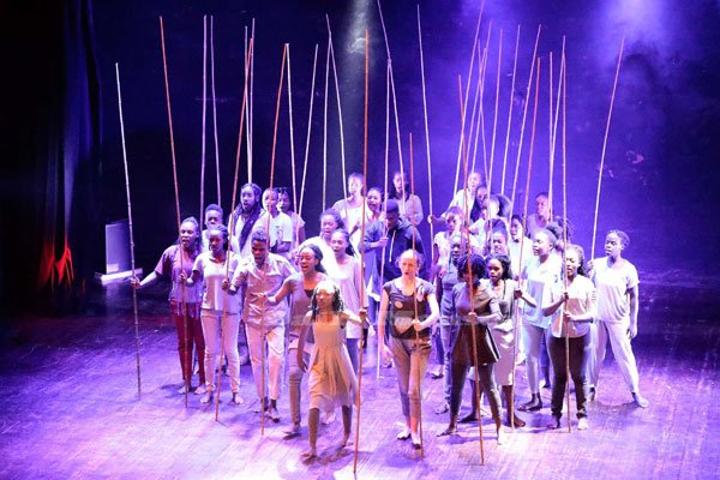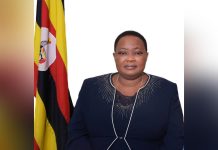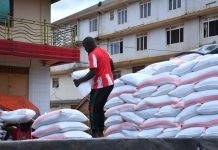Africa-Press – Uganda. Elvis Elasu, alias Levy, is a visual artist and a popping dancer. Prior to the global pandemic, Elasu, who is also the proprietor of the Jinja-based dance crew ‘Street Dance Force’, had scheduled a couple of performances to showcase his dance piece on teenage marriages dubbed Sukaali.
For now, Elasu has settled for painting not just to survive during the pandemic, but also to speak and sensitise the masses, as well as amplify people’s voices amidst the lockdown.
His latest mural depicts a face of an elderly man wearing a half torn face mask with a human hand trying to save water that ascends from a tap beneath his head.
Elasu’s story echoes the debate of misplaced priorities on relief and government expenditure on the Covid-19 pandemic.
His idea is that government spends more on utilities, although it also considers helping the elderly as people grapple to cope amid the pandemic.
Elvis Elasu poses by a mural of himself suggesting that art should take a digital path.
Just like Elasu, several other artists have come out to respond to the global pandemic with different messages that are veiled in different art genres.
Songs of hope
For musicians and performers, the pandemic has not just offered them an opportunity to connect with people, but also share their music on social media, and use it as a means to connect with the world outside.
Several musicians have used music to share messages of hope, guide the masses on how to deal with the pandemic and also communicate to the stakeholders.
Faisal Kiweewa, the proprietor of Bayimba International Festival of Music and Arts, says this is the time government should support the music industry by using it to communicate and bring hope to people.
“When listening to music that you enjoy, it creates a sense of pleasure and this boosts your mood. Music is great. This is why so many people listen to music when exercising and dancing,” he explains.
Producer and singer Sylver Kyagulanyi says the creative sector can play a crucial role to reconnect people during this pandemic.
“Music and art can help reconnect people with their loved ones in genuine ways amid lockdowns. However, it is a tool that can help bring back hope and nourish people’s minds and also lift spirits,” Kyagulanyi says.
The artiste, who has released several songs during the Covid-19 pandemic, says besides earning from his works, he is looking at helping people overcome stress and anxiety so as to boost their mental health.
The proprietor of Sikia studios in Kampala says his latest song, Tuyayaana (We are desperate), is a call for hope and a prayer for Christians to trust in God.
“We still look to God in these times of fear and painful contemplation of what is happening. I choose to pack the message in a song to give people hope,” he adds.
Kenneth Mugabi is another artiste who chose the same line. His song, Saasira (Forgive us), carries a couple of messages. Besides calling on God to heal the world, he calls out leaders who wash their hands to minimise the spread of the virus yet they have ill motives at heart, which disenfranchises the people they lead.
Mugabi notes that much as stakeholders are deploying all sorts of solutions to fight Covid-19, there is need for mindset change and call for empathy, a message he blends in his acoustic performance that has so far attracted at least 10,000 views on YouTube.
At the shock of the first wave of the pandemic, musician Robert Kyagulanyi, alias Bobi Wine, released a single dubbed Coronavirus Alert. The song echoed measures which people could use to avoid the pandemic.
Shared and interpreted globally, the song that attracted more than a million views on several YouTube channels was later endorsed by Unesco and other international media outlets.
Many other musicians have come up with lyrics and visuals to rally people to avoid flouting the standard operating procedures (SOPs) that have been put in place by authorities to check the spread of the deadly virus.
Film and the talking streets
Some artists have resorted to making street graffiti while either emphasising a message on stopping the spread of Covid-19 or airing out their views on how the pandemic is being handled by all stakeholders.
Away from talking streets, the film industry is also playing its part. Award winning film director Richard Mulindwa has a film in offing called Monica.
The movie features a young couple forced to marry in the middle of a pandemic.
The story is a real depiction of what exactly is going on, depicting the main character, Monica, as a school girl who is trapped at a boyfriend’s home and suddenly getting pregnant during the lockdown.
Many creatives in the film sector have lines in their works that are deliberately dedicated to saying a thing or two about the Covid-19 pandemic.
In addition, several drama-inspired clips have been shot to help in the dissemination of information in relation to the pandemic.
Virtual concerts and television
With the doors to concert venues still slum shut, art has basically gone digital since people currently get it on their handsets or the television.
Legendary artiste Halima Namakula is among the directors of the UG – Connect concert that is funded by the government through the Operation Wealth Creation (OWC) programme.
Halima says the agenda is not just to entertain or keep the artistes earning but also to break the burden of anxiety among the masses.
Halima explains that the online concert will offer a chance to 20 artists to perform to their fans every Saturday for 52 weeks.
Musicians, comedians and DJs equally entertain guests who watch a live streamed feed in the comfort of their living rooms.
E-concerts have also been bolstered with weekly TV dance party shows on several TV stations.
In similar queue, artists have also made it a tendency to hold sole digital concerts on social media and YouTube.
Singer Lily Kadima, who recently started her periodical YouTube performances dubbed Burning Bush, says she is utilising the lockdown to sing for her fans and talk to them about the pandemic.
History and pandemics
Studies show that arts play a big role in fighting against diseases since art can create awareness about a disease, while also providing psychosocial support to the victims.
A graffiti emphasising guidelines on how to fight Covid-19 in Makindye, Kampala. Photo/GABRIEL BUULE.
Dorothy Nabunjo, a talent manager and a proprietor of Karizm Uganda, explains that music can be a valuable tool of communication in health pandemics.
In Uganda, the creative industry has been at the centre stage of fighting HIV/Aids.
From late 1980s, theatre plays such as Gampisi and Bakayimbira’s Ndiwulira were used to communicate and alert people about the spread of HIV/Aids in Uganda.
Philly Bongole Lutaaya’s 1986 classic Alone and Frightened remains a strong advocate in the fight against HIV/Aids.
Other songs used in the fight against HIV/Aids include A little Bit of Love (All stars) and GNL Zamba’s Story ya Luka.
Not spared by the pandemic
A 2020 United Nation report on culture and education indicates that the culture sector, which employs more than 30 million people globally, has been hit much harder than expected by the coronavirus pandemic and its effects.
The report reveals that the film industry alone could lose about 10 million jobs this year, according to Unesco, while a third of the world’s art galleries could cut their staffing by half or more, data collected by the agency shows.
Similarly, what has been in effect a six-month closure of concerts and performance could end up costing the music industry more than $10 billion (Shs35 trillion) in lost sponsorships, while the global publishing market could shrink by 7.5 percent.
Entertainment Vs pandemic
In Uganda, hopes of reopening the entertainment industry still remain minimal.
Health minister Jane Ruth Aceng earlier hinted that vaccination of all most vulnerable Ugandans will influence the country’s reopening, as the President also always hinted.
Uganda aims to vaccinate at least 49.6 percent (about 21 million) of the population in different phases. Each phase is planned to cover 20 percent of the target population.
However, according to Reuter’s world coronavirus data tracker, Uganda has administered at least 1,143,763 doses of Covid vaccines as of early this week.
Elsewhere in the world
Globally, artists are approaching the situation differently, with some choosing to donate to vaccination programmes as the world grapples with vaccine inequality.
Kenneth Mugabi in a digital performance.
‘Donate for Doses’ is among the prominent initiatives that saw a ‘Concert for Covid-19 Vaccine Equity’ featuring American singers H.E.R., Jennifer Lopez, and J Balvin, among others.
The message behind the initiative is that Covid-19 vaccine distribution has been highly inequitable, especially on a global scale.
An established international advocacy organisation, Global Citizen, is putting up a benefit concert with ambitious fundraising goals for equitable vaccine distribution.
In April 2020, the initiative hosted “One World: Together: At Home,” a concert to unite, encourage folks to stay at home and support healthcare workers.
It featured Lady Gaga. According to Global Citizen, “One World: Together: At Home” helped raise about $128 million (about Shs500b) in support of healthcare workers in the fight against the Covid-19 pandemic.
Talking music and its contribution to global crisis, in 1985, a charity single We Are the World, written by Michael Jackson and Lionel Richie, and co-produced by Quincy Jones and Michael Omartian for the album ‘We Are the World’, was released for ‘USA for Africa’, which became the biggest-selling single of all time.
Not just that, the following year, USA for Africa’ raised and distributed more than $63 million (Shs221b) in revenue from the sale of more than seven million units of the album, singles and cassettes, plus nearly two million digital sales and related merchandise.
Just over half the total was spent on emergency relief (food, medicine, and refugee services) and the balance was used to support more than 500 different relief, rehabilitation and development projects in 18 different countries in sub-Saharan Africa.






